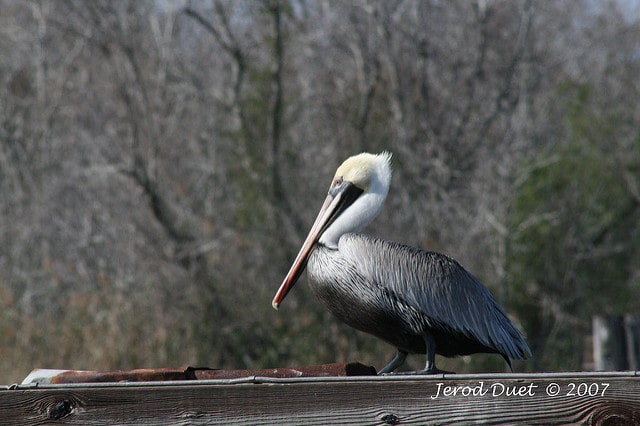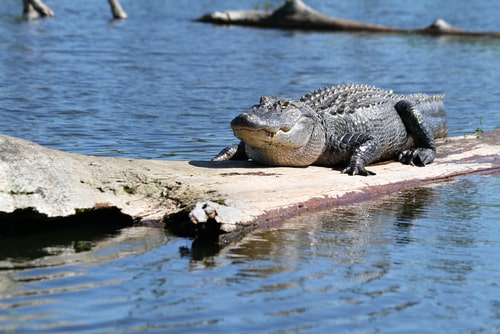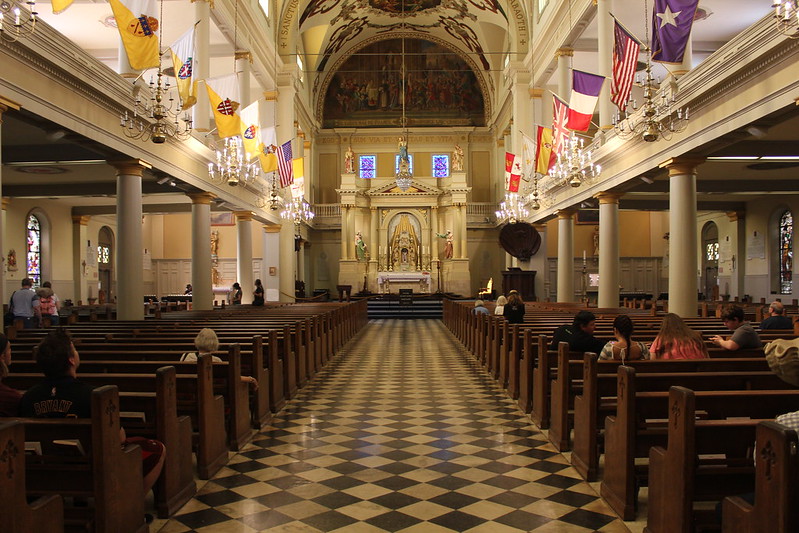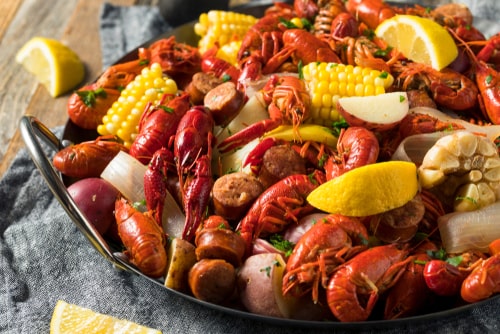Last updated on December 9th, 2025
Louisiana is the 25th most populous and the 31st most extensive of the 50 states of the United States. It lies in the southeastern region of the United States. The state attained statehood on April 30, 1812, becoming the 18th state to join the union. It shares its border with three states (Texas, Arkansas, and Mississippi.) See the full list of the 50 states and their borders here. Louisiana (nicknamed the Sugar State, the Bayou State, the Creole State, the Child of the Mississippi, the Pelican State) has 64 parishes. The state’s capital is Baton Rouge. The abbreviation for Louisiana is LA. With these facts about Louisiana, let us learn more about its history, geography, people, economy, etc.
Facts about Louisiana
1. The influence of early French and Spanish settlers is still present in the culture and food of the state.
2. The Louisiana State Capitol Building is the tallest state capital in the United States. The building was inaugurated on May 16, 1931. It is 450 feet tall and has 34 stories. This makes it an architectural standout among capitol buildings, which are typically built in a dome-style structure. In September of 1935, Long was assassinated in the State Capitol, which was built under his direction. Even today, a bullet hole in the marble wall remains as a visible, historical reminder of the event.
3. The nickname of the state “the Pelican State” comes from the many pelicans that used to inhabit the state’s Gulf Coast. (see the table at the end of the article for state symbols and nicknames)

4. The Louisiana black bear was designated the official state mammal of Louisiana in 1992.
5. Once threatened with extinction, the Louisiana black bear has made a remarkable recovery and was removed from the endangered species list in 2016.
6. Louisiana has the highest alligator population in the U.S. (approximately 2 million). The highest population of the alligator occur in coastal marshes. The state harvests less than 2% of the wild population annually.

7. The state of Louisiana also has the highest number of alligator hunters in the United States. Over 2,000 daring individuals venture into the swamps each year to catch between 30,000 and 35,000 of these impressive creatures.
8. Louisiana is among the country’s leading oil and gas-producing states.
9. With an average annual temperature of 68.5°F, Louisiana is the second warmest state in the United States. Florida tops the list with an average temperature of 73.4°F.
10. Louisiana does not have an official language. English, French, Spanish, and Vietnamese are the languages that are spoken in Louisiana.
11. Louisiana is one of the wettest states in the U.S. Hawaii overall is the rainiest state in the U.S.
12. Hurricane Katrina (as a Category 3 storm) devastated some parts of Louisiana in August 2005. The hurricane eroded 73 square miles of the Louisiana coastland. The hurricane caused the death of an estimated 1500 Louisianans. Moreover, the state endured more than $100 billion in damages. Louisiana witnesses hurricane season between June and November each year.

13. The official flag of Louisiana was adopted in 1912, one hundred years after Louisiana became a state.
14. “Louisiana My Home Sweet Home,” the state’s official march, was written by songwriter Sammie McKenzie and adopted as the state march in 1952.
15. Louisiana has been governed under ten different flags since 1541.
16. Between 1682 and 1763, Louisiana was a colony of the kingdom of France. In November 1762, France handed over Louisiana and the Isle of Orleans to Spain.
17. Louisiana was named by René-Robert Cavelier in mid-1600’s to honor King Louis XIV, King of France from 1643 to 1715.
18. President Thomas Jefferson purchased Louisiana from Napoleon Bonaparte in 1803. The purchase encompassed 530,000,000 acres of territory in North America that the U.S. purchased for $15 million. The purchase doubled the size of the United States. The Louisiana Purchase territory was so immense that it wasn’t just land for one state. It eventually formed all or part of 15 different American states and two Canadian provinces.
19. Native American tribes such as the Natchez, Bayougoula, and Chitamacha were the first inhabitants of what is now Louisiana.
20. Did you know the original Louisiana territory is now divided into 13 states?
Louisiana on the map
21. Interestingly, the shape of the state resembles the shape of the capital letter “L” or a boot.
22. The geographic center of Louisiana is located in Avoyelles Parish, 3 miles SE of Marksville. The state is about 380 miles long and 130 miles wide.
23. The Mississippi River borders and runs through the state. Because of the presence of the Mississippi River in Louisiana, Baton Rouge has become an important inland port.
24. The Port of South Louisiana, located on the Mississippi River, is the largest tonnage port in the Western Hemisphere and has more than 40 liquid and dry bulk terminals.
25. Launched in 1975, the iconic steamboat Natchez offers scenic cruises along the Mississippi River, providing visitors with a glimpse into the area’s riverboat history.
26. According to the NOAA, Louisiana has the third longest coastline out of all the states in the United States. It stretches for around 7,721 miles along the Gulf of Mexico.
27. Louisiana is known for its unique wetlands and swamps, including the iconic Atchafalaya Basin, the largest swamp in the United States. The Atchafalaya Basin stretches over almost 1 million acres.
28. Abita Springs in Louisiana has its own natural artesian spring, which has been used as a source of freshwater since the 1800s. Since 1986, the water from this spring has been used to brew the popular Abita Beer.
29. The beautiful Kisatchie National Forest is the only designated National Forest in Louisiana, offering over 600,000 acres of outdoor recreation opportunities.
30. Tammany Trace is a popular recreational trail spanning 31 miles and was once a railroad line. It now offers scenic biking, walking, and horseback riding opportunities.
31. The beautiful Lake Charles is home to the Charpentier Historic District, featuring over 40 blocks of well-preserved Victorian-era homes.
32. Driskill Mountain – 535 feet (163 m) above sea level is the highest point in the state. And New Orleans – 8 feet (2.5 m) below sea level is the lowest point in Louisiana.
33. The territory of Louisiana can be divided into three types of regions: lowlands, terraces, and hills.
34. In 1823, the first natural gas field was discovered in Louisiana. It was found at a depth of 400 feet.
35. Louisiana, because of the fertility of its land, was once one of the richest regions in America. Indigo, sugar, and cotton helped make the statesmen some of the richest Americans.
36. Baton Rouge is the site of an important battle during the American Revolution — the only one that happened outside of the original 13 colonies. US forces forged an alliance with the Spanish forces to take down the British colony here. The decisive victory ended the British hold of the Mississippi River.
37. The Battle of New Orleans, fought in January 1815, was a significant American victory during the War of 1812 and solidified Andrew Jackson’s reputation as a military hero.
38. In 1861, during the Civil War, Louisiana left the Union. It re-joined the United States in 1868.
39. In Natchitoches, Louisiana, you can find the oldest grocery store in the state. The Kaffie-Frederick General Mercantile store has been serving customers since 1863.
40. Parts of New Orleans, particularly the older areas, are situated below sea level. These areas are surrounded by levees that keep the Mississippi River and Lake Pontchartrain out. This location presents unique challenges, especially for burials. When traditional underground graves were used, the low water table and swampy ground often caused coffins to float to the surface during heavy rain or flooding. To solve this problem, New Orleans developed the practice of using above-ground tombs and mausoleums. These elaborate stone structures look like small houses or miniature temples and are often called the city’s “Cities of the Dead” due to their grand appearance.
41. Vieux Carré, or the French Quarter, in New Orleans, is the oldest neighbourhood in the city and showcases French and Spanish colonial architecture. The French founded this part of the city in 1718.

42. The St. Louis Cathedral in New Orleans, is the oldest continuously active Roman Catholic cathedral in the United States. It was officially the Cathedral-Basilica of Saint Louis, King of France (which is how it got its name). Today, the St. Louis Cathedral remains a powerful symbol of the city’s deep Catholic heritage.
43. The cathedral’s current structure was completed in 1794, replacing two earlier churches on the same spot that were destroyed by fire. The St. Louis cathedral overlooks Jackson Square and has been the site of countless historical events. Serving as a spiritual anchor for the city for over two centuries, it is truly an enduring American landmark.
44. Natchitoches (pronounced NACK-a-tish) is an enchanting town that was founded in 1714 and is the oldest permanent settlement in the Louisiana Purchase territory. The city was established by the French explorer Louis Juchereau de St. Denis, long before New Orleans, as a trading post on the Red River near a Spanish fort in Texas. This gave it an important role in trade between the French and the Spanish colonies. Though it is much smaller than New Orleans, its history is older. Natchitoches is famous for its historic district and its Christmas Festival of Lights, which draws hundreds of thousands of visitors each year.
45. The unique architecture of shotgun houses, characterized by their narrow structure and rooms laid out in a single line, has been a part of the Louisiana landscape since early in the 19th century.
46. In 1853, the Cabildo Building became the home of the Louisiana Supreme Court.
47. Founded in 1906, the Louisiana State Museum, located in the historic French Quarter, preserves and showcases the state’s diverse cultural heritage.
48. The Jean Lafitte National Historical Park and Preserve encompasses six different sites, highlighting the region’s cultural and ecological significance.
49. The Louisiana State Museum’s Cabildo building in New Orleans housed the Spanish municipal government during the late 18th century. It was built from 1795 to 1799 and was the site of the Louisiana Purchase transfer.
50. The Louisiana Museum of Natural History, located at the University of Louisiana at Monroe, houses over 8 million specimens, making it one of the largest natural history collections in the South.
51. There are 11 recognized Native American tribes in Louisiana, making the state home to the largest number of Native American tribes east of the Mississippi River, including the Choctaw, Chitimacha, and Houma tribes.
52. Louisiana is home to several significant Native American mound sites, including Poverty Point, a UNESCO World Heritage site. It stands as a stunning example of ancient engineering. The site consists of massive earthwork mounds and rings built by indigenous people as far back as 1700 BCE (Before the Common Era), making it older than the pyramids of Egypt. Experts believe the area was a huge trading center and ceremonial site, possibly for religious or solar observation purposes. The enormous effort required to build these structures without modern tools shows the complexity of the ancient cultures living in North America.
53. Louis Cemetery No. 1 in New Orleans is one of the oldest and most famous above-ground cemeteries in the United States. This historic cemetery was established in 1789.
54. More than 1,600 farmers produce crawfish across more than 11,000 acres of ponds in the state of Louisiana.

55. In 1959, Breaux Bridge, a city in the St. Martin Parish, was designated as the “Crawfish Capital of the World.” This was done to honor the region which was known for its crawfish farming and cooking. Louisiana is the largest producer of crawfish in the United States, accounting for over 90% of the nation’s total production.
56. Louisiana also made important contributions to the United States space exploration program. The state facilitated the production of the C-5 boosters used in the Apollo moon landing program.
57. Louisiana is the only state in the U.S. with political subdivisions termed parishes, which are local governments equivalent to counties. The state has 64 parishes. Note that Jefferson Parish is the largest parish-based on population, while Cameron Parish is the largest by land area.
58. The term “parishes” comes from the French and Spanish colonial eras when the territory was governed by the Catholic Church. The church divided the land into parishes for administrative and religious purposes.
59. Alexandria: contrary to popular belief, the city was not named after the famous ancient Egyptian center of scholarship. Rather it takes its name from the daughter of the Pennsylvania businessman Alexander Fulton who organized the first settlement here back in 1785.
. . . continue reading on the next page
